plymouth
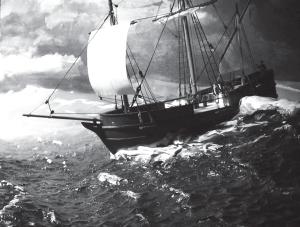 The dangers of the Cape Cod shoals are well known to the seamen who regularly navigate those waters. Almost from the time the shoals were discovered, they have been wreaking havoc on the ships that have the misfortune of getting too close to them. Sailors know that they need to steer clear of the Cape coast. Thousands of ships have been destroyed on its bars and rocks, and with the lost ships, uncounted lives too have been lost in the storm-tossed waves. When the storms were raging and a ship got caught, there was no way for rescuers to get to the trapped crew and passengers. The storms battered the trapped ships until they sank.
The dangers of the Cape Cod shoals are well known to the seamen who regularly navigate those waters. Almost from the time the shoals were discovered, they have been wreaking havoc on the ships that have the misfortune of getting too close to them. Sailors know that they need to steer clear of the Cape coast. Thousands of ships have been destroyed on its bars and rocks, and with the lost ships, uncounted lives too have been lost in the storm-tossed waves. When the storms were raging and a ship got caught, there was no way for rescuers to get to the trapped crew and passengers. The storms battered the trapped ships until they sank.
Oddly, Cape Cod is both a hazard and a haven to the mariners. All shipping between Boston and New York must either pass into its sheltered bay or run aground on its treacherous shoals. It is only the skill of the mariners that determines the difference. The shoals, when combined with the forces of 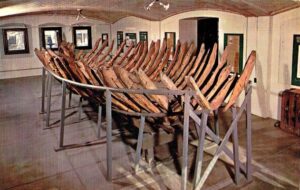 countless Nor’easters put the Cape in a precarious location. Because of this, the Cape has been the site of more than 3,000 shipwrecks in 300 years of recorded history.
countless Nor’easters put the Cape in a precarious location. Because of this, the Cape has been the site of more than 3,000 shipwrecks in 300 years of recorded history.
One of the first recorded wrecks was that of the Sparrow Hawk. The Sparrow Hawk originally hailed from London, England. It was making a six-week voyage to Virginia when it ran aground off Nauset Harbor in 1626. A gale arose and forced the vessel over the bar into the harbor. The ship ran aground near Orleans. The area isn’t always so dangerous. When the tide is low, people aboard the ships were able to get ashore safely when their ships ran aground. When Sparrow Hawk grounded, some English-speaking Indians arrived and offered to conduct them to Plymouth or carry a message. Grateful, they accepted and once ashore, they sent a message which brought Governor William Bradford with repair material. The ship was soon repaired, but before it could set sail, the ship was sunk by another storm. The sunken ship was abandoned.

The second wreck would be more permanent, as the ship wasn’t seen for over 200 years. The wreckage reappeared on May 6, 1863, after the sand shifted. The exposed remains of the ship reappeared only briefly. Because of the vessel’s unusual shape, two local men made a drawing of it. The ship was an oddity, and it drew many visitors. The visitors, when they came to see, nearly all took a fragment of the ship for a souvenir before it was again covered by sand in August of 1863. Since they now knew where the ship was, it has since been excavated, and the ribs of the ship were removed and transferred to the Pilgrim Hall Museum in Plymouth, where it is to this day.
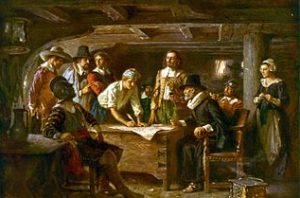 The September 6, 1620 trip to the new world, in which 102 passengers, who had been dubbed Pilgrims by William Bradford, one of the passengers who would become the first governor of Plymouth Colony, was a crowded, grueling trip on the Mayflower to a new life in the New World. The trip was filled with hardship, and sometimes even loss. Nevertheless, the pilgrims knew it had to be taken. The situation actually began in 1606, when a group of reform-minded Puritans in Nottinghamshire, England, founded their own church, that was separate from the state-sanctioned Church of England. This was truly the reason why “Freedom of Religion” is such an important part of our constitution. Many people dispute that fact that our nation was formed on religious principles, but it was, from the very core of the move here.
The September 6, 1620 trip to the new world, in which 102 passengers, who had been dubbed Pilgrims by William Bradford, one of the passengers who would become the first governor of Plymouth Colony, was a crowded, grueling trip on the Mayflower to a new life in the New World. The trip was filled with hardship, and sometimes even loss. Nevertheless, the pilgrims knew it had to be taken. The situation actually began in 1606, when a group of reform-minded Puritans in Nottinghamshire, England, founded their own church, that was separate from the state-sanctioned Church of England. This was truly the reason why “Freedom of Religion” is such an important part of our constitution. Many people dispute that fact that our nation was formed on religious principles, but it was, from the very core of the move here.
On November 11, 1620, the Mayflower anchored at what is now Provincetown Harbor, Cape Cod. Of course, it was mandatory that they scout out the new land to make sure it 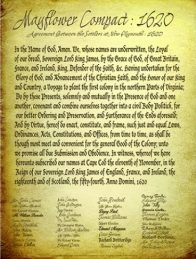 was safe before bringing the women and children there. Before going ashore, 41 male passengers…heads of families, single men and three male servants…signed the famous Mayflower Compact, agreeing to submit to a government chosen by common consent and to obey all laws made for the good of the colony. Over the next month, several small scouting groups were sent ashore to collect firewood and scout out a good place to build a settlement.
was safe before bringing the women and children there. Before going ashore, 41 male passengers…heads of families, single men and three male servants…signed the famous Mayflower Compact, agreeing to submit to a government chosen by common consent and to obey all laws made for the good of the colony. Over the next month, several small scouting groups were sent ashore to collect firewood and scout out a good place to build a settlement.
Around December 10, one of these groups found a harbor they liked on the western side of Cape Cod Bay. They returned to the Mayflower to tell the other passengers, but bad weather prevented them from docking until December 18. After exploring the region, the settlers chose a cleared area previously occupied by members of a local Native American tribe, the Wampanoag. The travel weary pilgrims finally prepared to begin their new settlement, Plymouth Colony. The Wampanoag tribe had abandoned the village several years earlier, after an outbreak of European disease. That winter of 1620-1621 was brutal, as the Pilgrims struggled to build their settlement, find food and ward off sickness. They were less than highly successful, because by spring, 50 of the original 102 Mayflower passengers were dead. The remaining settlers made contact with returning  members of the Wampanoag tribe, and in March they signed a peace treaty with a tribal chief, Massasoit. Aided by the Wampanoag, especially the English-speaking Squanto, the Pilgrims were able to plant crops…especially corn and beans…that were vital to their survival. The Mayflower and its crew left Plymouth to return to England on April 5, 1621.
members of the Wampanoag tribe, and in March they signed a peace treaty with a tribal chief, Massasoit. Aided by the Wampanoag, especially the English-speaking Squanto, the Pilgrims were able to plant crops…especially corn and beans…that were vital to their survival. The Mayflower and its crew left Plymouth to return to England on April 5, 1621.
Over the next several decades, more and more settlers made the trip across the Atlantic to Plymouth, which gradually grew into a prosperous shipbuilding and fishing center. In 1691, Plymouth was incorporated into the new Massachusetts Bay Association, ending its history as an independent colony. And the rest, as they say, is history.
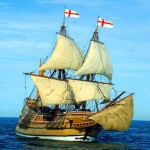 Thanksgiving Day is behind us for this year, of course, but today is a day that ties into Thanksgiving in a big way. On September 16, 1620, the Mayflower left Plymouth, England on its way to the New World. I can’t begin to imagine how so many of our ancestors must have felt at that time. It was going to be a long voyage, and some of them might not make it to the end of the trip, but going was worth the risk. There were 102 passengers on the 90 foot ship. The ship was bound for Virginia, where the colonists half of whom were religious dissenters and half of whom were entrepreneurs, and all of whom had been authorized to settle in the New World by the British crown. The trip was difficult, with rough seas and storms that blew the ship 500 miles off course. When they landed, it was in Massachusetts and not Virginia that the colonists found themselves, and I guess they were not bound by the exact location, because no one was there to tell them that they had to move. So they settled there.
Thanksgiving Day is behind us for this year, of course, but today is a day that ties into Thanksgiving in a big way. On September 16, 1620, the Mayflower left Plymouth, England on its way to the New World. I can’t begin to imagine how so many of our ancestors must have felt at that time. It was going to be a long voyage, and some of them might not make it to the end of the trip, but going was worth the risk. There were 102 passengers on the 90 foot ship. The ship was bound for Virginia, where the colonists half of whom were religious dissenters and half of whom were entrepreneurs, and all of whom had been authorized to settle in the New World by the British crown. The trip was difficult, with rough seas and storms that blew the ship 500 miles off course. When they landed, it was in Massachusetts and not Virginia that the colonists found themselves, and I guess they were not bound by the exact location, because no one was there to tell them that they had to move. So they settled there.
I did not recognize anyone on the passenger list that I specifically knew to be related to me, but there were numerous sir names that I have seen in my own family history. In researching the genealogy of the people from the Mayflower however, I find that we are related to some of them because, some of the people that we know that we are related to are related to some of them. An expedition of men was sent out to scout the land, and the ship remained anchored at the tip of Cape Cod in what is now Provincetown harbor in present day Provincetown, Massachusetts. While the men were out scouting for a suitable place to build a town, Susanna White, a passenger on the ship, gave birth to her second child, a son named Peregrine. He was the first English child born in New England.
The expedition found a suitable place to settle, with cleared fields and plentiful water. They returned to the ship and the ship was moved to what is now Plymouth Harbor, arriving on December 21st. Two days later, on December 23, 1620, construction began on the settlement that was to be named Plymouth…this day 394 years ago. The first year was really difficult, with half of the people dying of disease. It was a difficult time for the colonists. It wasn’t until 1621 that the health of the people improved…as did the economic condition, with a great harvest.
To celebrate, the governor, William Bradford invited neighboring Indians to Plymouth to celebrate the bounty of the year’s harvest, in what would become the first Thanksgiving Day celebration. The people secured peace treaties with the Indians, and soon more people were attracted to the settlement of Plymouth. By the 1640s the population was over 3,000, but was nevertheless, overshadowed by the larger population of the  Massachusetts Bay Colony that was started by Puritans in 1629.
Massachusetts Bay Colony that was started by Puritans in 1629.
Nevertheless, it would be the Plymouth colony who would have the honor of hosting the first Thanksgiving, and the honor of being know as the first Pilgrims. The name pilgrim did not come into being until the early 19th century and it was from a manuscript written by Govern Bradford in which he spoke of the “saints” who traveled to the New World as “pilgrimes” in 1620. Orator Daniel Webster spoke of the “Pilgrim Fathers” at a bicentennial celebration of Plymouths founding. The name pilgrim stuck and they have been know as such in history ever since. So, while Thanksgiving is past, believe it or not, its beginning actually happened on December 23, 1620, almost a year before the actual event took place.
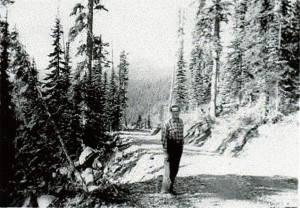 During the Depression years, many people were looking for work…any kind of work, because jobs were scarce, and money even more so. Many men were forced to leave their wives and young children to run the farms, so they could go out, sometimes several states away to look for work. It wasn’t just the husbands either. Many times, as in the case of my dad and my Uncle Bill, it was the sons who had to go find jobs too, because the family was simply not going to make ends meet if they didn’t. So it was that Dad and Uncle Bill set out for the Whitefish, Montana area to look for work. This trip would be quite an experience for the two brothers, who were in their teens at the time. It is my guess that my dad would have been around 15 years and Uncle Bill 17 years old at this time, but I could be off by a year or two. It doesn’t matter, because they were, nevertheless young.
During the Depression years, many people were looking for work…any kind of work, because jobs were scarce, and money even more so. Many men were forced to leave their wives and young children to run the farms, so they could go out, sometimes several states away to look for work. It wasn’t just the husbands either. Many times, as in the case of my dad and my Uncle Bill, it was the sons who had to go find jobs too, because the family was simply not going to make ends meet if they didn’t. So it was that Dad and Uncle Bill set out for the Whitefish, Montana area to look for work. This trip would be quite an experience for the two brothers, who were in their teens at the time. It is my guess that my dad would have been around 15 years and Uncle Bill 17 years old at this time, but I could be off by a year or two. It doesn’t matter, because they were, nevertheless young.
They got to Fosston, Minnesota that first night…taking it easy on Uncle Bill’s old Plymouth, and arriving about 8:30pm. They tried to find a room to rent for the night, but there were  none, and then someone said they could sleep at the jail, so they went to check it out. They were allowed to spend the night there, after showing identification, being searched, and leaving all their belongings except their clothes in the office. I’m sure they were really wondering if they would turn them loose the next morning, after such an ordeal, but while the beds were not the most comfortable, they had a place to sleep. Needless to say, they left Fosston the next morning, and headed to Osnabruck, North Dakota the next day, where they found work unloading bags of cement from a rail road box car. By the end of the day, they were exhausted and pretty certain that they couldn’t have lifted one more bag…no matter how much money was offered. They found a man and his son who had a threshing machine and several farms lined out to do threshing for, but not enough help, so they worked for him until continued rain ended the threshing for the year.
none, and then someone said they could sleep at the jail, so they went to check it out. They were allowed to spend the night there, after showing identification, being searched, and leaving all their belongings except their clothes in the office. I’m sure they were really wondering if they would turn them loose the next morning, after such an ordeal, but while the beds were not the most comfortable, they had a place to sleep. Needless to say, they left Fosston the next morning, and headed to Osnabruck, North Dakota the next day, where they found work unloading bags of cement from a rail road box car. By the end of the day, they were exhausted and pretty certain that they couldn’t have lifted one more bag…no matter how much money was offered. They found a man and his son who had a threshing machine and several farms lined out to do threshing for, but not enough help, so they worked for him until continued rain ended the threshing for the year.
Then, they decided to get out of North Dakota, and headed for Whitefish, Montana where they worked in the lumber business for a company called Kinshella Lumber, in the 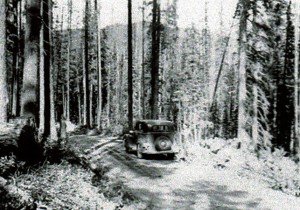 beautiful mountains outside Whitefish. That area was one that they found to be a great place for adventure, and they spent a lot of time driving in the mountains when they were working. It was a time they would remember fondly, until October arrived, bringing with it some very cold weather. By this time, both boys were pretty much done with this trip, so they set out for home, with enough money to make another payment on the farm. They had an interesting adventure, to say the least, but I’m sure that grandma’s good cooking and their own beds were calling their names, and as Uncle Bill said, there was wood to be cut up for the stove.
beautiful mountains outside Whitefish. That area was one that they found to be a great place for adventure, and they spent a lot of time driving in the mountains when they were working. It was a time they would remember fondly, until October arrived, bringing with it some very cold weather. By this time, both boys were pretty much done with this trip, so they set out for home, with enough money to make another payment on the farm. They had an interesting adventure, to say the least, but I’m sure that grandma’s good cooking and their own beds were calling their names, and as Uncle Bill said, there was wood to be cut up for the stove.

